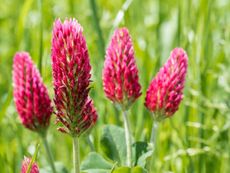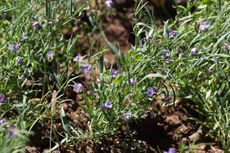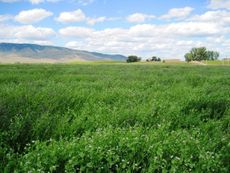What Is Triticale – Learn How To Grow Triticale Cover Crops


Cover crops are not just for farmers. Home gardeners can also use this winter cover to improve soil nutrients, prevent weeds, and stop erosion. Legumes and grains are popular cover crops, and triticale as a cover crop is great alone or as a mix of grasses and cereals.
Triticale Plant Information
Triticale is a grain, all of which are types of domesticated grass. Triticale is a hybrid cross between wheat and rye. The purpose of crossing these two grains was to get the productivity, quality of grain, and disease resistance from wheat and the hardiness of rye in one plant. Triticale was developed decades ago but never really took off as a grain for human consumption. It is most often grown as forage or feed for livestock.
Farmers and gardeners alike are beginning to see triticale as a good choice for a winter cover crop. It has a few advantages over other grains, like wheat, rye, or barley:
- Triticale produces more biomass than other grains, which means there is more potential for adding nutrients to the soil when plowed under in the spring.
- In many areas, triticale can be planted earlier than other grains because it has a higher resistance to certain diseases.
- Winter triticale is very hardy, hardier than winter barley.
- As compared to winter rye, winter triticale produces fewer volunteer plants and is easier to control.
How to Grow Triticale as a Cover Crop
Growing triticale cover crops is pretty straightforward. You just need seeds to sow. Triticale can be sown any time from late summer to early fall in any area of your garden in which you need to enrich the soil or prevent weed growth. Just be sure to sow the seeds early enough for your area that they will be established before the weather turns really cold. Adding a complete fertilizer to the soil before sowing will help the triticale get better established.
Sowing triticale is similar to growing grass from seed. Rake the soil, spread the seeds, and rake the soil again. You want the seeds lightly covered to prevent birds from eating them. The best part of growing cover crops is that they are low maintenance.
Once they start growing, they won’t need much attention. In the spring, mow the triticale down really low and plow it into the soil about two to three weeks before you want to plant your garden.
Gardening tips, videos, info and more delivered right to your inbox!
Sign up for the Gardening Know How newsletter today and receive a free download of our most popular eBook "How to Grow Delicious Tomatoes."

Mary Ellen Ellis has been gardening for over 20 years. With degrees in Chemistry and Biology, Mary Ellen's specialties are flowers, native plants, and herbs.
-
 How To Get Rid Of Mosquitoes In The Garden: 9 Natural Ways To Make Them Buzz Off!
How To Get Rid Of Mosquitoes In The Garden: 9 Natural Ways To Make Them Buzz Off!How to get rid of mosquitoes is on the minds of people in the summer in almost every region of the world. Learn how to repel the pests without toxic chemicals.
By Mary Ellen Ellis
-
 Monkey Orchid Care: How To Grow This Fascinating Species
Monkey Orchid Care: How To Grow This Fascinating SpeciesThe monkey orchid (Dracula simia) bears a remarkable resemblance to its namesake and, with a little know-how, can be successfully grown as a houseplant.
By Bonnie L. Grant
-
 Best Late Summer And Early Fall Cover Crops
Best Late Summer And Early Fall Cover CropsPlanting cover crops is a gift you can give to your garden’s soil. Read on to learn about planting cover crops in late summer.
By Bonnie L. Grant
-
 Sunn Hemp Plant Info – Learn Sunn Hemp Uses And Care
Sunn Hemp Plant Info – Learn Sunn Hemp Uses And CareSunn hemp grass is a warm weather grass. Click to learn more about Sunn hemp uses as well as helpful tips on growing Sunn hemp as a cover crop.
By Mary H. Dyer
-
 Native Cover Crops: Vegetable Cover Cropping With Native Plants
Native Cover Crops: Vegetable Cover Cropping With Native PlantsAre there any benefits to using native plants as cover crops? Click here to learn more about vegetable cover cropping with native plants.
By Laura Miller
-
 What Is Field Brome – Information About Field Brome Grass
What Is Field Brome – Information About Field Brome GrassField brome grass can be used as a cover crop to control erosion and enrich the soil. For more information, click the following article.
By Laura Miller
-
 What Is Western Wheatgrass – How To Grow Western Wheatgrass
What Is Western Wheatgrass – How To Grow Western WheatgrassWheatgrass is native to North America and graces the Southwest, Great Plains and mountainous regions of the western U.S. It has some erosion control benefits but using western wheatgrass for grazing is the primary purpose. Learn more about it here.
By Bonnie L. Grant
-
 What Is Chickling Vetch – Growing Chickling Vetch For Nitrogen Fixing
What Is Chickling Vetch – Growing Chickling Vetch For Nitrogen FixingWhat is chickling vetch? Also known by various names such as grass pea, white vetch, blue sweet pea, Indian vetch, or Indian pea, chickling vetch is a nutritious legume grown to feed livestock and humans in countries around the world. Learn more about the plant here.
By Mary H. Dyer
-
Establishing Kura Clover: Learn How To Grow Kura Clover Plants
You no doubt have heard about the four-leaf clover, but few gardeners are familiar with kura clover plants. Kura is a forage legume and if you are interested in growing kura as a groundcover or establishing kura clover for some other use, this article will help.
By Teo Spengler
-
 What Are Austrian Winter Peas: A Guide To Growing Austrian Winter Peas
What Are Austrian Winter Peas: A Guide To Growing Austrian Winter PeasWhat are Austrian winter peas? Also known as field peas, Austrian winter peas have been grown around the world for centuries, primarily as a valuable source of nutrition for humans and livestock. Click this article for info on growing Austrian winter peas.
By Mary H. Dyer